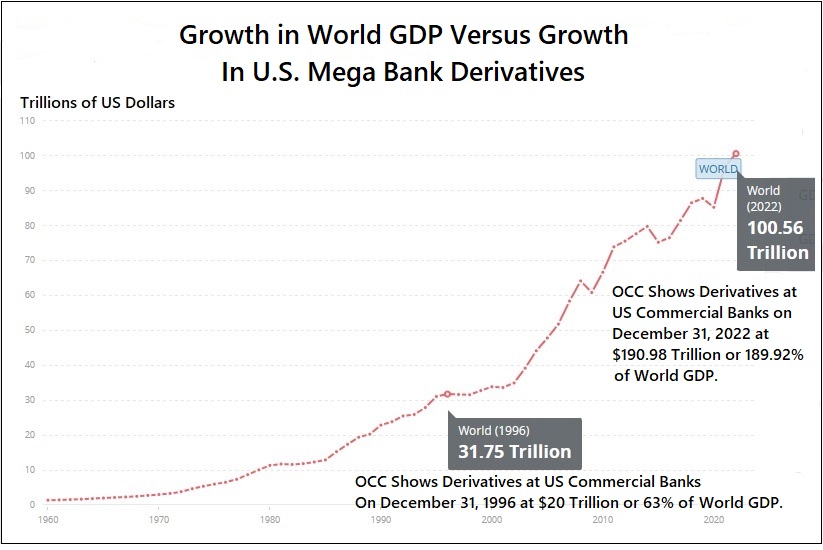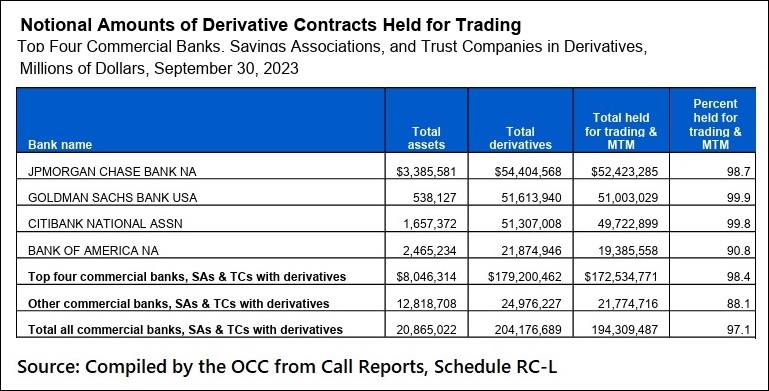At recent Congressional hearings on federal bank regulators’ newly proposed rules to force the largest banks in the U.S. to hold more capital against their riskiest trading positions (so that taxpayers aren’t on the hook for more bailouts), the banks and their sycophants holding Senate and House seats made it sound like it’s the American farmers who will be hurt because the derivatives they use to hedge against crop failures or price swings in their crops will become more expensive..
We knew this was a completely bogus argument because the latest data from the U.S. Department of Agriculture indicates that “agriculture, food, and related industries contributed roughly $1.264 trillion to U.S. gross domestic product (GDP) in 2021….”
In other words, U.S. farmers need to hedge less than $2 trillion while just three mega banks on Wall Street were holding $157.3 trillion in derivatives as of September 30 of this year – which is $56.74 trillion more than the GDP of the entire world last year. (See chart above.)
If the bulk of these derivatives aren’t being used by farmers and business owners to hedge against losses, what are they being used for? According to the Office of the Comptroller of the Currency (OCC), the federal regulator of national banks, the trillions of dollars in derivatives at the mega banks on Wall Street are being used for trading – likely for the benefit of the banks themselves or their billionaire speculator clients, such as hedge funds and family offices.
According to the OCC, as of September 30, JPMorgan Chase (which lost $6.2 billion from its federally-insured bank in wild derivative trades in 2012) is still allowed to sit on $54.4 trillion in derivatives. Citigroup’s Citibank, which blew itself up in 2008 from derivatives and off-balance-sheet vehicles and received the largest bailout in global banking history, is sitting on more derivatives today than at the time of its crash in 2008. OCC data shows Citibank with $35.6 trillion in derivatives on September 30, 2008 (see Table 1 in the Appendix here) versus a staggering $51.3 trillion as of September 30, 2023. Goldman Sachs, whose federally-insured bank has just $538 billion in assets, has $51.6 trillion in derivatives. (In what alternative universe from hell would Goldman Sachs be allowed to own a federally-insured bank?)
Then there is the matter of concentrated risk. According to the FDIC, as of September 30, there were 4,614 federally-insured banks and savings associations in the U.S. – the vast majority of which found no need to involve the bank in derivatives at all. But, for some inexplicable reason, three banks with highly dubious histories have been allowed to establish insane levels of concentrated risk in derivatives. The $157.3 trillion in derivatives held by JPMorgan Chase Bank, Citibank and Goldman Sachs Bank USA represent 77 percent of all derivatives held by all 4,614 federally-insured financial institutions in the U.S. (See chart below.)
The chart at the top of this page shows how this derivative problem has grown since the repeal of the Glass-Steagall Act in 1999. The repeal removed the ban of casino trading houses on Wall Street merging with federally-insured banks. Today, every giant federally-insured bank on Wall Street owns a trading house. In 1996, prior to the repeal of Glass-Steagall, derivatives at U.S. banks represented just 63 percent of world GDP. At the end of last year, derivatives at U.S. banks represented 189.92 percent of world GDP.
To prevent a replay of the banks blowing themselves up as they did in 2008 while their federal regulators were napping, federal banking regulators in July proposed to impose higher capital rules on just 37 banks – those significantly engaged in derivatives and other high-risk trading strategies.
The backlash has been fierce, with the mega banks even running television ads painting a bogus and distorted picture of what the capital increases would do.
Another critical question is who is on the other side of these derivative trades with the mega banks and may blow up if they took the wrong side of the trade?
According to federal researchers, there are both mega bank counterparties as well as “non-bank financial counterparties” – which could be insurance companies, brokerage firms, asset managers or hedge funds. There are also “non-financial corporate counterparties” – which could be just about any domestic or foreign corporation. To put it another way, the American people have no idea if they own common stock in a publicly-traded company that could blow up any day from reckless dealings in derivatives with global banks.
This is not some far-fetched fantasy. Wall Street has a history of blowing up things with derivatives. Merrill Lynch blew up Orange County, California with derivatives. Some of the biggest trading houses on Wall Street blew up the giant insurer, AIG, with derivatives in 2008, forcing the U.S. government to take over AIG with a massive bailout.









